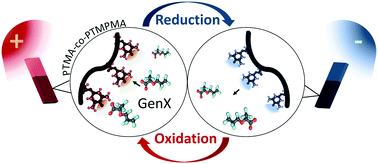Emerging investigator series: electrochemically-mediated remediation of GenX using redox-copolymers†
Abstract
Per- and polyfluorinated alkyl substances (PFAS) are persistent contaminants that have been continuously detected in groundwater and drinking water around the globe. Hexafluoropropylene oxide dimer acid (tradename GenX) has been used to substitute traditional PFAS, such as PFOA, but its intense use has caused widespread occurrence in water streams and often in high levels. Here, we evaluate a redox-copolymer, poly(4-methacryloyloxy-2,2,6,6-tetramethylpiperidin-1-oxyl-co-4-methacryloyloxy-2,2,6,6-tetramethylpiperidine) (PTMA-co-PTMPMA), for the selective electrochemical removal of GenX. The amine functional groups promote affinity towards the anionic PFAS, and the redox-active nitroxide radicals provide electrochemical control for adsorption and desorption. Faster kinetics and higher uptake (>475 mg g−1 adsorbent) were obtained with the redox-copolymer when applying 0.8 V vs. Ag/AgCl potential compared to open circuit. The copolymer electrosorbents were evaluated over a wide pH range and diverse water matrices, with electrostatic-based mechanisms dependent on the state of protonation of the PFAS. Moreover, we translated the redox-electrodes from a batch to flow-by cell configuration, showing successful adsorption and release of GenX under flow and electrochemical control. Finally, prolonged exposure of GenX at reduction potentials generated smaller PFAS fragments at the redox-electrodes. To fully defluorinate GenX, the copolymer-functionalized electrodes were coupled with a boron-doped diamond (BDD) counter electrode for integrating separation and defluorination within the same device. The combined system demonstrated close to 100% defluorination efficiency. Thus, we highlight the potential of electroactive redox platforms for the reactive separation of fluorotelomers, and point to future directions for their practical implementation for water treatment.

- This article is part of the themed collections: Emerging Investigator Series and Environmental Science: Water Research & Technology Recent HOT Articles


 Please wait while we load your content...
Please wait while we load your content...
